Industries
National Handloom Day 2025
Weaving Innovation into Tradition
Posted On:
06 AUG 2025 1:29PM
|
“We take immense pride in the rich heritage and vibrant tradition of handlooms across our nation. We also cherish the efforts of our artisans and reiterate our commitment to be ‘Vocal for Local.”
- Prime Minister Narendra Modi
|
Introduction
The Indian handloom industry is one of the oldest and most vibrant cottage industries in the world. With a legacy dating back thousands of years, it reflects India’s rich culture and skilled craftsmanship. Indian weavers have long been known for their expertise in hand-spinning, weaving and printing skills. They are located in small towns and villages across the country, where skills are passed down from one generation to the next.
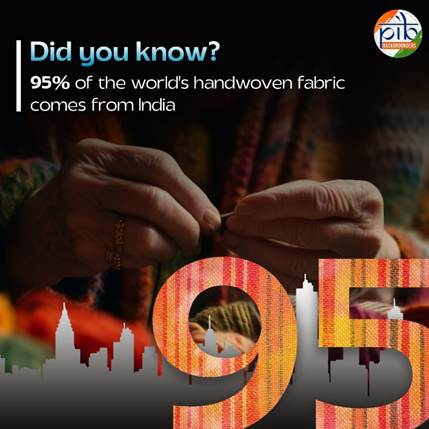
From Swadeshi to Self-Reliance
The handloom sector played a vital role in India’s freedom movement. The Swadeshi Movement, launched on 7th August 1905, championed indigenous industries, especially handlooms, as a form of economic resistance to colonial rule.
In honour of this legacy, the Government of India declared 7th August as National Handloom Day in 2015. The first celebration was inaugurated by Prime Minister Shri Narendra Modi in Chennai. Since then, this day is observed every year to honour the weaving community, recognise their contribution to the nation’s socio-economic development, and renew our collective resolve to preserve and promote India’s handloom heritage.
11th National Handloom Day: Celebrating Craftsmanship and Excellence
The 11th National Handloom Day will be celebrated on 7th August 2025 at Bharat Mandapam, New Delhi. The event will be graced by the Hon’ble President of India, who will confer the prestigious Sant Kabir Handloom Awards and National Handloom Awards for 2024 to a total of 24 awardees, including 5 Sant Kabir Awardees and 19 National Awardees.
These awards are part of the Handloom Marketing Assistance (HMA) component under the National Handloom Development Programme (NHDP). They recognise the work of weavers, designers, marketers, start-ups and producer companies who have made a difference in the field.
Each Sant Kabir Award carries a cash prize of ₹3.5 lakh, a gold coin (mounted), a Tamrapatra, a shawl, and a certificate. Each National Handloom Award includes a cash prize of ₹2 lakh, a Tamrapatra, a shawl, and a certificate.
The Handloom Hackathon – A Fresh Approach to Old Challenges
To support the handloom sector in adapting to modern challenges, the Ministry of Textiles launched Handloom Hackathon 2025, held on 4th August 2025 at the Research and Innovation Park, IIT Delhi. Organised by the Development Commissioner (Handlooms) in collaboration with the National Design Centre and FITT, IIT Delhi, the initiative marked a significant step towards innovation-led growth in the sector.
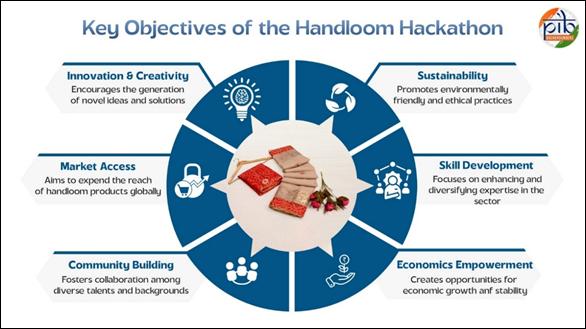
Theme: “DREAM IT; DO IT”
The hackathon invited participation from college students, fashion designers, engineers, researchers, and weavers. Selected ideas received national-level recognition and continued support from the Ministry for implementation. The initiative not only enabled practical problem-solving but also built valuable networks to ensure long-term impact on the handloom ecosystem.
Week-long Celebrations: 1st to 8th August 2025
As part of the 11th National Handloom Day celebrations, the Ministry of Textiles has curated a week-long series of events in New Delhi to honour India’s rich handloom legacy and engage new audiences.
Weaving Bonds: Reconnecting Youth with India’s Handloom Traditions
Know Your Weaves Campaign (1st–7th August) at the National Crafts Museum & Hastkala Academy, New Delhi - This flagship initiative is designed to reconnect younger generations with India’s handloom traditions, bringing together school and college students for an immersive experience. It features:
- Live weaving demonstrations by master artisans from different states
- Interactive storytelling on iconic weaves like Banarasi, Chanderi, Kanchipuram, and Pochampally
- Workshops on natural dyeing, loom techniques, and textile art
- Student activities including guided tours, quizzes, and creative installations
The campaign is not only educational but also builds emotional and cultural connections between youth and the weaver community.
Other key highlights include:
- Saree Festival at Handloom Haat, Janpath (3rd–10th August) – Exhibition showcasing 116 weaves of handloom sarees
|
- Fashion Show ‘Vastra Veda’ at Bharat-Mandapam and ‘Naad’ at the Ashoka Hotel, Chanakyapuri (7th August) – ‘Vastra Veda – The Handloom Heritage of India’ on important handlooms weaves of different regions and ‘Naad– The Music of Weaves’ on exclusive weaves
|
- India International Hand-woven Expo at Bharat Mandapam (7th–9th August) – bringing together international buyers, exporters, and weavers to promote Indian handlooms globally
|
Handlooms: A Lifeline of Rural India and Keeper of Heritage
The handloom sector is a big part of life in rural India. For many families, it is not just a tradition but also their main source of income. Weaving is often done at home with the usage of simple looms. It doesn’t need a lot of money to start, which makes it perfect for small villages and towns.
Today, handloom weaving is India’s largest cottage industry. According to the 4th All India Handloom Census (2019–20), about 35.22 lakh households are involved in this work. Together, they include over 35 lakh weavers and allied workers.
One of the most important parts of this sector is the role of women. Around 72% of economic handloom weavers are women. For many of them, weaving offers both income and economic independence. This is why many government schemes focus on helping women weavers and giving them more support.
Handlooms are more than just fabric. They carry the stories of our people, places and traditions. From Banarasi to Kanjeevaram, every weave reflects India's rich heritage. Made through eco-friendly methods, handlooms support rural families, empower women and promote sustainable living. They truly reflect who we are.
Rich Variety of Indian Handlooms
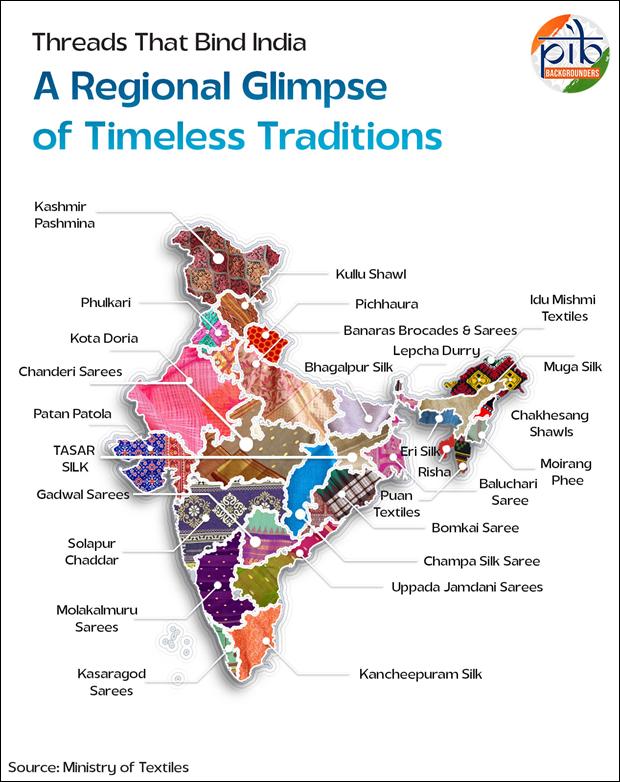
India’s handloom sector is known for its wide range of fabrics, including cotton, khadi, jute, linen, and rare fibres like Himalayan nettle. It also produces distinctive silk varieties such as Tussar, Mashru, Mulberry, Eri, Muga and Ahimsa, along with woollen weaves like Pashmina, Shahtoosh and Cashmere.
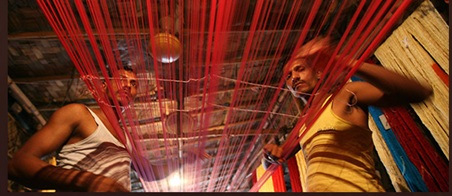
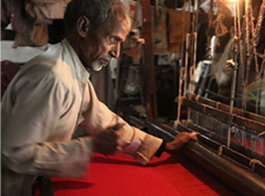
Every region in India has developed its own unique handloom style. For example, Rajasthan is known for its tie and dye, Madhya Pradesh for Chanderi, and Uttar Pradesh for Jacquard patterns. These distinct traditions have made Indian handlooms popular both in India and around the world for their detailed designs and artistic value.
Other well-known styles include Bomkai from Odisha, Kunbi from goa, Paithani from Maharashtra, Kotpad from Oisha , Balarampuram from Kerala , Jamdani and Baluchari from West Bengal Each piece is handmade using traditional methods, making every product unique.
Indian Handlooms in Global Markets
Indian handlooms are celebrated across the globe for their rich textures, earthy colours and intricate craftsmanship. Every weave tells a story, and it’s this cultural depth and uniqueness that give Indian handloom products a special place in homes and hearts around the world.
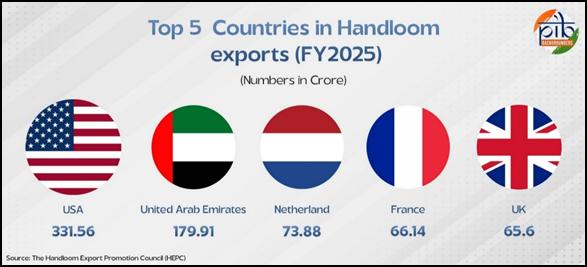
Building on its rich heritage, India has emerged as the world’s only major producer of handloom fabrics at a commercial scale. Remarkably, nearly 95 per cent of the world’s handwoven fabric is made in India. While similar sectors in other countries have declined or disappeared, India’s handloom tradition has continued to thrive, sustained by deep-rooted cultural values and the enduring skill of its weavers
India’s handloom exports continue to find strong demand across global markets, reaching over 20 countries. In FY 2024-25, the United States remained the largest destination, accounting for ₹331.56 crore worth of exports. The United Arab Emirates followed with ₹179.91 crore, while the Netherlands imported goods worth ₹73.88 crore. France and the United Kingdom were close behind at ₹66.14 crore and ₹65.6 crore respectively. These figures reflect the continued global appreciation for the craftsmanship and cultural value of Indian handloom products.
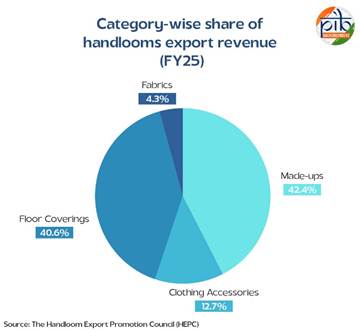
In terms of products, made-ups such as cushion covers, curtains, table linen and other household items contributed the largest share of export revenue at 42.4 percent in 2024-25. These were closely followed by floor coverings like carpets, rugs and mats, which made up 40.6 percent. Clothing accessories contributed 12.7 percent, while fabrics accounted for 4.3 percent of the total.
With their traditional charm and eco-friendly appeal, Indian handloom products continue to attract buyers worldwide. From living rooms in Europe to boutiques in the Middle East, Indian weaves are making their mark, one thread at a time.
Government Schemes for Handloom Development
The Government of India, through the Ministry of Textiles, implements several important schemes to promote the handloom and handicraft sectors across the country, including rural areas.
The key schemes are:
- National Handloom Development Programme
- Raw Material Supply Scheme
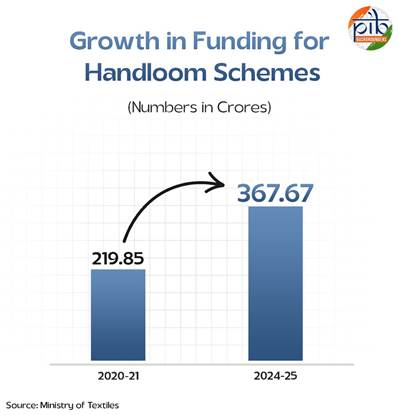
These schemes offer financial support for raw materials, purchase of looms, tools and accessories, design innovation, product diversification, infrastructure development, marketing both domestically and internationally, and concessional loans to beneficiaries.
The funds released under these schemes have grown steadily over the years. Back in 2020-21, the support was around Rs. 219.85 crore, and by 2024-25, it increased to over Rs. 367.67crore. This rise reflects the government’s stronger focus on empowering handloom and handicraft communities across India.
National Handloom Development Programme (NHDP)
The National Handloom Development Programme (NHDP) aims to promote the sustainable growth of handloom weavers in and outside recognised clusters by forming self-reliant and competitive units.
The scheme takes a need-based, holistic approach to support weavers. It provides help with raw materials, design, technology upgrades, marketing through exhibitions, and building permanent infrastructure like Urban Haats and marketing complexes.
|
Components under NHDP
|
2014-15 to 2023-24
|
2024-25
|
|
Small Cluster Development Programme
|
|
|
|
No. of clusters sanctioned
|
715
|
79
|
|
Amount released (Rs. in crore)
|
533.17
|
85.99
|
|
No. of beneficiaries covered
|
2,16,579
|
12,221
|
|
Handloom Marketing Assistance
|
|
|
|
No. of marketing events sanctioned
|
2316
|
177
|
|
Amount released (Rs. in crore)
|
302.42
|
35.77
|
|
No. of beneficiaries covered
|
37,59,380
|
4,86,040
|
|
No. of products/items registered under GI Act, 1999
|
73
|
31
|
|
Weavers MUDRA Loan
|
|
|
|
No. of beneficiaries sanctioned loans
|
2,90,212
|
9,211
|
|
Handloom Weavers Welfare
|
|
|
|
No. of weavers enrolled under PMJJBY/PMSBY
|
24,86,697
|
1,42,126
|
Raw Material Supply Scheme (RMSS)
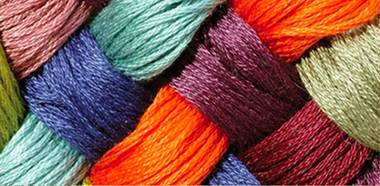
The Yarn Supply Scheme (YSS), now partially modified and renamed as the Raw Material Supply Scheme (RMSS), has been approved for implementation for the period 2021–22 to 2025–26. The scheme aims to support handloom weavers by ensuring the availability of quality yarn at affordable prices through the following key objectives and components.
Objectives
- Provide quality yarn and blends to eligible handloom weavers at subsidised rates.
- Set benchmark prices and maintain consistent quality and supply.
- Supply dyed yarn to address poor dyeing facilities and support product diversification.
- Support handloom weavers in competing with the mill sector.
Subsidy
Under the scheme, freight charges are reimbursed for all type of yarns and component of 15% of yarn subsidy is there for cotton hank yarn, domestic silk, wool and linen yarn and blended yarn of natural fibers with quantity cap, so that handloom weavers may can compete with power-looms in pricing.
MUDRA Loan
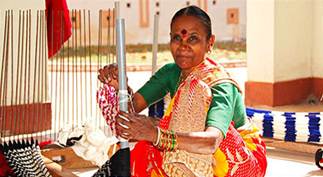
This scheme offers subsidised loans to weavers through banks at a low interest rate of 6%. To support these loans, individual weavers can get margin money up to Rs. 25,000, while organisations can receive up to Rs. 20 lakh. The Ministry also pays the credit guarantee fee to banks to encourage lending. To make the process easier, the Online Handloom Weavers MUDRA portal has been created for direct transfer of margin money to weavers’ accounts, along with interest support and credit guarantee payments to banks.
Other Significant Initiatives by the Government of India
Marketing Assistance
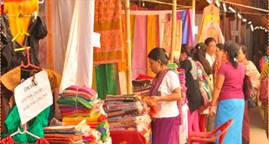
Expos and District level events are organised regularly to provide a marketing platform to the handloom weavers. Weavers are also facilitated to participate in various crafts melas held across the country. As a new initiative, 23 e-commerce companies have been engaged to promote e-marketing of handloom products.
Certification of Handloom Products
The Handloom Mark was launched in 2006 to provide a distinct identity to handloom products. In 2015, the India Handloom Brand (IHB) was introduced for branding high-quality handloom products. It aims to create a direct link between the weaver and the consumer, offering the former better earnings and the latter an assurance of quality. Leading brands like BIBA, Peter England, and ONAYA have launched exclusive handloom collections with IHB.
Small Cluster Development Programme (SCDP)
The Small Cluster Development Programme focuses on developing weavers’ groups as visible and self-sustainable entities. Need-based financial assistance of up to ₹2 crore per cluster is provided for interventions such as the purchase of looms and accessories, lighting units, workshed construction, solar lighting systems for common worksheds, engagement of textile designers, and product development activities.
Skill Up-gradation
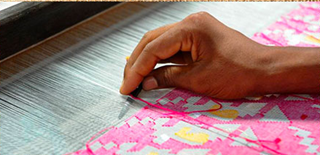
Weavers and allied workers receive training to learn new weaving techniques, adapt to modern technologies, and develop new designs and colours. Training also covers eco-friendly dyeing practices, exposure to basic accounting and management, and familiarisation with e-commerce platforms.
Hathkargha Samvardhan Sahayata (Looms and Accessories)
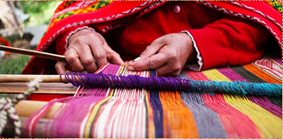
This scheme aims to improve fabric quality and productivity through the adoption of upgraded looms, jacquards, dobbies, etc. Under the scheme, 90% of the cost is borne by the Government of India, while implementation is carried out with full involvement of the respective State Governments.
Workshed Scheme
The scheme provides dedicated workspace near the weaver’s home for the entire family. Each unit costs ₹1.2 lakh. Marginalised households, including female, BPL, SC, ST, transgender, and differently-abled weavers, are eligible for 100% financial assistance, while other beneficiaries receive 75% assistance.
Engagement of Designers
Professional designers are engaged within clusters and beyond to develop innovative designs and products. The scheme covers their fees and offers additional financial outlay for remuneration to support design activities and establish marketing linkages.
Protecting Traditional Designs
The Ministry is actively working to safeguard India’s unique handloom patterns by helping register them under the Geographical Indication (GI) Act, 1999. It also supports awareness through seminars and workshops. So far, a total no. of 104 handloom products, out of a total no. of 658 GI tagged products have been registered under the GI Act.
Empowering through Producer Companies
To improve productivity and earnings, more than 163 Producer Companies (PCs) have been set up across various states. These collectives help weavers manage their businesses better and access larger markets.
Going Digital with GeM & indiahandmade.com
Weavers are also being supported in selling their products online. Around 1.80 lakh weavers have been onboarded onto the Government e-Marketplace (GeM), allowing them to sell directly to government departments and institutions.2418 sellers onboarded on indiahandmade.com and 11410 products uploaded.
Welfare Measures for Handloom Weavers
The Ministry of Textiles continues to provide social security to handloom weavers across India. Social security is ensured through insurance schemes like the Pradhan Mantri Jeevan Jyoti Bima Yojana (PMJJY), Pradhan Mantri Suraksha Bima Yojana (PMSBY) and converged Mahatma Gandhi Bunkar Bima Yojana (MGBBY). These offer coverage against natural and accidental death, as well as disability.
Awardee weavers above 60 years of age, living in indigent conditions and earning below ₹1 lakh annually, are provided financial support of ₹8,000 per month. In addition, their children (up to two) are eligible for scholarships of up to ₹2 lakh per year for pursuing diploma, undergraduate, or postgraduate studies in government-recognised textile institutions.
Conclusion
National Handloom Day is a heartfelt celebration of India’s weaving traditions and the people who keep them alive. The 11th edition is not only recognising their contributions through prestigious awards but also bringing fresh momentum with forward-looking initiatives such as the Handloom Hackathon 2025. Through new ideas, collaborations, and technology, the sector is taking firm steps toward resilience and renewal.
As we mark this special day, we reaffirm our collective promise, to empower our artisans, especially women; to protect India’s rich weaving traditions; and to ensure that the threads of heritage, sustainability, and self-reliance continue to weave a strong and vibrant future.
References
Ministry of External Affairs
Ministry Of MSME
Ministry of Textiles
Handloom Export promotion Council
Click here to see PDF
SK / M
(Backgrounder ID: 154978)
आगंतुक पटल : 7718
Provide suggestions / comments